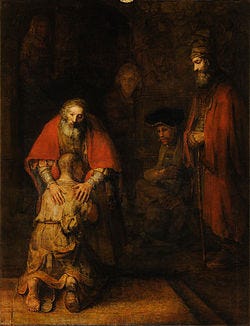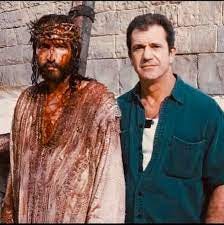The pastor told me that he had invited representatives of the various Western views to speak on a series of Sundays, and wanted me to come tell the congregation about Orthodox beliefs. He thought that it was right to use all of the beliefs about the Atonement.
I wasn’t sure about that, because in the West there’s a fundamental belief that Jesus paid the debt for our sins to the Father, which is incompatible with the Orthodox idea (and I would say, the biblical idea) that the Father forgives our sins for free.
That Sunday morning I found a very friendly congregation, ready to learn. I planned to base my talk on my most recent book, Two Views of the Cross. The cover shows a Dutch painting of the Crucifixion from the early 1600s, and a Greek icon that was made about the same time. If you compare them, you can see there’s a great difference in how the Crucifixion was understood.

In the Dutch painting, Christ really looks like a corpse, crushed, defeated, sagging down, with greenish-gray skin. Blood flows freely from all his wounds. But the icon is different. There, Christ looks like he is standing with his arms lifted, almost as if he is displaying the Cross to us. The Cross is Christ’s throne. It is an emblem of victory.
In the book I make three points, for those who want to understand the Orthodox view of the Atonement. First, that we inherit a weakness in the face of sin that’s a basic part of broken human nature, passed down the generations from the Fall of Adam and Eve. Giving in to sin weakens us further, and we get helplessly pushed around by the lies of the evil one. “The wages of sin is death” (Romans 6:23), and all people, even the righteous, passed from this life to become helpless prisoners of Death.
The Cross is the culmination of a plan in which Jesus put on human form, and submitted to death—but there in Hades he revealed his divinity, and broke its iron bars. That’s why Jesus looks triumphant on the Cross: He has vanquished the evil one, he has come to rescue us.
There’s another piece, though. What about the debt for all those sins we have committed? The Orthodox believe that God just forgives us. He wipes away that debt, because he loves us, like the father of the Prodigal Son running toward his returning boy.
And, third, what about Jesus’ death being a sacrifice to the Father? A sacrifice is not a payment. A sacrifice is a gift given to formalize a covenant. When two kings met to agree to a treaty, each would bring costly gifts for the other, as evidence of their commitment. (The only thing we have like that today is an engagement ring.)
But, properly speaking, a sacrifice was always something edible, and a new covenant is sealed by eating a meal together. Christ said that the cup, at the Last Supper, was “the new covenant in my blood” (Luke 22:20). Jesus is the sacrifice we make to the Father—and Jesus is also the gift from the Father to us, because he “so loved the world that he gave his only-begotten Son” (John 3:16).
My book, Two Views of the Cross, is pretty short, but it still contains too much to explain in a 20-minute talk. I gave the most emphasis to that middle part, about God’s free forgiveness, because that’s where the most misunderstanding lies.
Orthodox Christians believe that the Father forgives us for free. He does not require any payment before he forgives us. He is not bound by justice, so that he can’t forgive us till the debt is paid. He forgives us for free.
The clearest example is that father, in Jesus’ parable of the Prodigal Son (Luke 15:11-32). The son has treated his father with extreme disrespect. He demanded to be given his inheritance early, as if saying to his father “You are dead to me.” Then he went far away—not just a few miles off to sulk, but to a “far country,” putting as much distance between himself and his father as he could.
You already know what happened next. The son wasted all his money, “came to himself,” and decided to go home, apologize, and ask to be taken in as a servant.
But Jesus tells us that the father sees his son “while he was yet a long way off.” That means his father must have been looking for him. He had been searching the horizon, gazing into the distance, hoping to see that wayward son return.
So picture this. When the son came into view, the father waited for him to make his weary way back. The son then showed his deep repentance, but the father said, “I’d love to take you back, son, but look at this Visa bill! Who’s going to pay that? You’ve got to repay every penny before I can forgive you.”
Well, that’s obviously not what the father said. Jesus tells us that, from the moment the father saw his son, he was stirred with deep compassion He ran to his son and embraced him and kissed him. He didn’t say anything about repaying the debt. He simply forgave him, just like that.

Western Christians can have trouble grasping how that works. I know I did, when I was a new convert, 30-something years ago. The sins of the world are an enormous debt, and surely somebody has to pay it. It can’t just go unpaid. But what we see in Jesus’ parable is that a father does exactly that; he forgives his son without repayment.
That’s what “forgiveness” actually means, isn’t it? Jesus has another parable about a man who had loaned money to two people; “one owed 500 denarii, and the other 50. When they could not repay, he graciously forgave them both” (Luke 7:41-42). The man simply dismissed the debt; someone else didn’t step in and pay it.
Here’s an analogy that I hope helps clarify things. Say you’re finishing up a restaurant meal, and you ask for the bill. The waiter says, “No charge—the manager has forgiven your debt.”
Or he might say, “No charge—the man at that table paid your debt.”
The first is forgiveness. The second is third-party payment. God did the first; he actually forgave us.
But Western Christianity has lost the early, Orthodox view, and come to see the Cross as third-party payment.
How did that happen? A new idea came into Western theology around the time of the Great Schism, which separated the Eastern and Western Churches. The usual date pinned on that is AD 1054, though it took place gradually, over a long period of time. 1054 is just a handy peg to hang your hat.
The new idea came from a French monk named Anselm, who was the Archbishop of Canterbury.

He lived in the feudal era, when a great lord had absolute rule over his manor, and multitudes of serfs farmed his land and did his bidding. This lord was accorded great honor, and the serfs had to treat him with respect.
If a serf somehow insulted the lord, it didn’t matter if he said he was sorry; the lord was not free to simply forgive him. The serf would have to do something to restore the lord’s injured honor. He would have to render some kind of restitution, or to use the old word, satisfaction, before he could be forgiven.
St. Anselm reasoned that God’s honor must be higher than that of any human being. And all the sins of humanity were grievous insults to that honor. If God was going to forgive us, satisfaction had first to be made.
Anselm said that, when Jesus died on the Cross, he gave the Father a gift of infinite value. Now the Father is indebted to the Son, and owes him a great reward. If Jesus decided to give that reward to us, how could the Father stop him? “One who freely gives so great a gift to God must not be without a reward,” Anselm wrote. “If the Son willed to give his reward to others, could the Father justly prohibit it, or refuse to bestow it on them?”
You can see what’s appealing about that idea. If God forgives us for free, as in the Orthodox understanding, his love is so overwhelming, so irrational (in human terms), that it’s scary. It’s a good bit more comfortable to think that a third party, Jesus, paid the debt we owe to God. That’s a satisfying kind of idea—a “satisfaction” theory of the atonement in another sense.
Over time, this view was elaborated by different thinkers. In Anselm’s theory, Jesus paid our debt, so no punishment for our sins was necessary. But later thinkers said that Jesus took our punishment in his agony on the Cross. There was a punishment, but Jesus took it for us. Still others said he bore the wrath of the Father. Our sins fill God with rage, and it could not be spent until he saw his Son’s suffering and death. Western Christian art depicted Jesus as utterly abject, powerless, crushed. I saw this line attributed to Mel Gibson once, but haven’t been able to trace it: “Every drop of blood pays for a sin.”

How very unlike the father of the Prodigal son that is. He watched for his son, ran to him, embraced him, and rejoiced. He had every reason to demand satisfaction, and even deal out punishment. But, instead, the father of the Prodigal forgave.
Apparently, in Jesus’ time it was conceivable that someone might hold high honor and yet forgive an injury without repayment. And it’s conceivable in our time as well: though the pope holds the highest honor in Western Christianity, when Pope John Paul II was shot, he went to the prison and forgave his assailant. He forgave him freely, without any satisfaction.
The Cross is a gift, an emblem of victory, a perfect offering—the Cross is many things. But it is not a transaction.
I said earlier that there are two other ideas I’d bring in, to fill out the picture of Orthodox Atonement theory a little further. This next one illustrates biblical words like ransom, rescue, redeem, and save.
Seeing humans lost in a sea of transgressions, God came to our rescue. The Fall of Adam and Eve broke something in human nature, so that we are weak before temptation and keep falling into sin. Participating in sin weakens us further, in a vicious cycle. We were lost in this confusion, and could never escape it by our own powers. We needed to be rescued.
Jesus and the Father are on the same team. They worked together to rescue us from the grip of the evil one, and freed us from the prison of Death. Jesus became human so he could pass into the realm of Death, just like every other human being. But once there he revealed his glory and destroyed its prison bars, setting the captives free.
And there’s that third piece I referred to earlier, that Jesus is Paschal Sacrifice, offered by us to the Father, and given to us by the Father, establishing the new covenant in Jesus’ blood.

We don’t have time to go deeper into that, but I hope this discussion of God’s free forgiveness can help Western and Eastern Christians understand each other better. The congregation that day sure seemed intrigued. (And if you want to get the whole picture, with all the Scripture citations, look for Two Views of the Cross on Amazon or wherever fine books are sold.)
